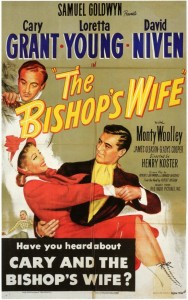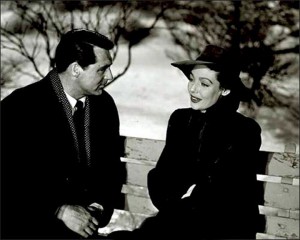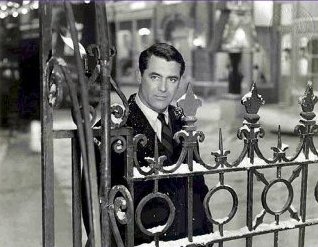Nobody expects him be normal; he’s a bishop.
1947 was long enough after World War II that people wanted to forget the conflict and were, in fact, busy getting on with their lives, so war films were, naturally, passé. The year reflected a considerable drop in quality films from the Himalayan peaks of the late ’30s, though, true, 1947 was still a part of Hollywood’s Golden Age.
The weak movies in the Oscar race for Best Picture suggest the decline. Down to five since 1944, among the nominations were two sentimental films (The Bishop’s Wife and Miracle on 34th Street), two about anti-Semitism (Crossfire and Gentleman’s Agreement) and one clear masterpiece, the British Great Expectations. The masterpiece did not receive the little gold man, as it should have, but the winner, Gentleman’s Agreement, was the better of the two message movies and, yes, the second best effort of the year.
 1947 was the last year the trade magazine Daily Variety would conduct and publish a pre-ceremony poll of how Academy members voted. This caused something of an embarrassment this year. Throughout the awards ceremony, the poll generally tallied with the actual winners—except for Best Actress. Based on the survey, Rosalind Russell was the presumed shoe-in for Mourning Becomes Electra, a long, so-so film, and the least likely to win—after Dorothy McGuire, Joan Crawford and Susan Hayward, in that order—was the dark horse, Loretta Young, for The Farmer’s Daughter. But she won!
1947 was the last year the trade magazine Daily Variety would conduct and publish a pre-ceremony poll of how Academy members voted. This caused something of an embarrassment this year. Throughout the awards ceremony, the poll generally tallied with the actual winners—except for Best Actress. Based on the survey, Rosalind Russell was the presumed shoe-in for Mourning Becomes Electra, a long, so-so film, and the least likely to win—after Dorothy McGuire, Joan Crawford and Susan Hayward, in that order—was the dark horse, Loretta Young, for The Farmer’s Daughter. But she won!
For the first time in Academy history a foreign-language film, Italy’s Shoe-Shine, was honored. The classification would remain honorary, with a single film recognized, until 1956 when a specific category would be established, with the usual five nominations.
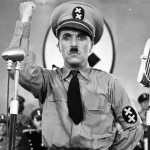 Sentimental films have always populated the Best Film nominations—and win surprisingly often, especially compared with adventure and, for that matter, war films. Even in 1940, the last year before the U.S. entered WWII, there was the slapstick/satire, The Great Dictator, with only one other war-related film, Alfred Hitchcock’s Foreign Correspondent, a warning, in its final shots, that war was coming.
Sentimental films have always populated the Best Film nominations—and win surprisingly often, especially compared with adventure and, for that matter, war films. Even in 1940, the last year before the U.S. entered WWII, there was the slapstick/satire, The Great Dictator, with only one other war-related film, Alfred Hitchcock’s Foreign Correspondent, a warning, in its final shots, that war was coming.
The only “war” nomination In 1941, albeit about the previous world war, was Sergeant York, which cleverly lent support for the current goings-on in Europe. This before December 7th.
In 1942, with the U.S. finally in the conflict after Pearl Harbor, there were three war film nominations—Mrs. Miniver, The Invaders and Wake Island—plus that final scene in Yankee Doodle Dandy, when a silhouetted Franklin Roosevelt congratulates George M. Cohan (James Cagney) on his war contributions. Not Tinsel Town fiction, FDR had actually awarded Cohan the Congressional Gold Medal in 1936—for his efforts during WWI.
1943’s escapist “feel good” comedies, Ernst Lubitsch’s Heaven Can Wait and Frank Capra’s The More the Merrier, plus the ethereal The Song of Bernadette and the bio, Madame Curie, were pitted against pretty dire stuff: The Ox-Box Incident, a dark, Shakespearean morality tale of mob rule in the West, and four (4) war movies, Watch on the Rhine, a stage transfer; In Which We Serve, essentially a Noel Coward one-man show; For Whom the Bell Tolls, with Gary Cooper and Ingrid Bergman; and Casablanca, one of the greatest films of all time—and the Best Picture winner.
The Academy returning to only five nominations in 1944, David O. Selznick’s sprawling tribute to the home front, Since You Went Away, was the only war-themed film. And an obvious “escape” from the gravity of films about homegrown insanity (Gaslight), murder for insurance money (Double Indemnity) and a high-toned presidential bio (Wilson), “fluff” was suddenly respectable, now that the European war was nearing its end. The Oscar winner which filled that need was Going My Way.
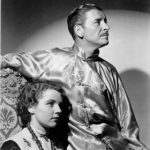 Its sequel in 1945, The Bells of St. Mary’s, was properly ignored in favor of The Lost Weekend, a ground-breaking study of alcoholism, with a one-time Oscar for Ray Milland. The still unsettled civilian life was reflected in stories of an over-protective mother (Mildred Pierce) and a psychoanalytic trip (Spellbound). There were no “war” Best Picture nominations that year. Had World War II been forgotten—so soon?
Its sequel in 1945, The Bells of St. Mary’s, was properly ignored in favor of The Lost Weekend, a ground-breaking study of alcoholism, with a one-time Oscar for Ray Milland. The still unsettled civilian life was reflected in stories of an over-protective mother (Mildred Pierce) and a psychoanalytic trip (Spellbound). There were no “war” Best Picture nominations that year. Had World War II been forgotten—so soon?
No. Despite 1946 being the first year of peace in the decade, the subject in two films that year shifted to post-war living—The Razor’s Edge, an ex-soldier philosophizing about the meaning of life, and The Best Years of Our Lives—the winner—war veterans adjusting to civilian domesticity. 1947 and ’48 would be “war free,” followed, in 1949, with two war tributes—one to the Battle of the Bulge in Battleground, the other to the air war waged by an American bomber base in England, Twelve O’Clock High.[See the separate review of Twelve O’Clock High.]
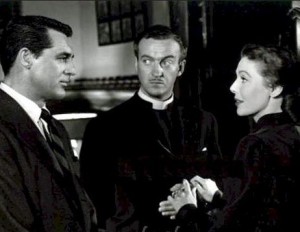 The Christmas movie, The Bishop’s Wife, was the unofficial Protestant answer in 1947 to the Catholic Going My Way from 1944. The film boasts a superb cast, first in its three major stars. Dudley (Cary Grant) is an angel sent to answer the prayers of Bishop Henry Brougham (David Niven), who is raising money to build “his” cathedral. The bishop’s wife, Julia (Loretta Young), more than her husband, is distraught by their growing marital discord. Predictably, Dudley reunites them and, at the same time—he after all does have some clout—gets Henry his cathedral, but not exactly in the manner the bishop had envisioned.
The Christmas movie, The Bishop’s Wife, was the unofficial Protestant answer in 1947 to the Catholic Going My Way from 1944. The film boasts a superb cast, first in its three major stars. Dudley (Cary Grant) is an angel sent to answer the prayers of Bishop Henry Brougham (David Niven), who is raising money to build “his” cathedral. The bishop’s wife, Julia (Loretta Young), more than her husband, is distraught by their growing marital discord. Predictably, Dudley reunites them and, at the same time—he after all does have some clout—gets Henry his cathedral, but not exactly in the manner the bishop had envisioned.
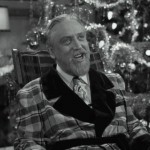 The supporting players reinforce the superb casting, typical of the time. Monty Woolley had played gruff old men with hearts of gold in at least two previous films, Since You Went Away and The Man Who Came to Dinner. Here, as retired history professor Wutheridge, whom Dudley pretends to know, he is outwardly anti-Christmas—protesting the price of a scraggly little tree, for instance—but he’s one of the first to sense and appreciate Dudley’s heavenly source and powers, which, strangely, Julia never does. Wutheridge, even, could be seen as the pivot of the entire film.
The supporting players reinforce the superb casting, typical of the time. Monty Woolley had played gruff old men with hearts of gold in at least two previous films, Since You Went Away and The Man Who Came to Dinner. Here, as retired history professor Wutheridge, whom Dudley pretends to know, he is outwardly anti-Christmas—protesting the price of a scraggly little tree, for instance—but he’s one of the first to sense and appreciate Dudley’s heavenly source and powers, which, strangely, Julia never does. Wutheridge, even, could be seen as the pivot of the entire film.
Special effects support Dudley’s spiritual status with small, minor miracles—a self-contained typewriter pecks away as he dictates and a wave of his hand files index cards and decorates a Christmas tree. He also has more substantial powers—prompting people to change their minds in midstream or tardy choir boys to suddenly appear from the wings to perform Charles Gounod’s Noël. Dudley’s materializations are simple enough, without ghostly images, heavenly lights, or an echoing voice. A change of camera angle and he’s either there or he isn’t, and he looks like everyone else.
Wutheridge is recipient of the best magic in the film—the wine glasses which never become empty. When entertaining Dudley and Julia in his crowded apartment, the professor drinks continually, but, unnoticed, Dudley’s moving finger constantly refills the glass. Several times Wutheridge attempts to refill his glass, only to find it already full. At one point, he says, observing the still full wine bottle, “We don’t seem to be making any headway.” Later, after Dudley and Julia have left, Wutheridge drinks one last glass, his back to, this time, an empty bottle—necessary for the “magic.” As he puzzles, for the first time, over an empty glass, the bottle behind him slowly refills!
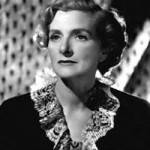 In dowager Agnes Hamilton, Gladys Cooper reprises the kind of role she made her own, that of the elegant, though domineering, sometimes insensitive matriarch—in Rebecca, Now, Voyager, Separate Tables. Like Woolley, she is not as minor a character as her place in the credits might suggest.
In dowager Agnes Hamilton, Gladys Cooper reprises the kind of role she made her own, that of the elegant, though domineering, sometimes insensitive matriarch—in Rebecca, Now, Voyager, Separate Tables. Like Woolley, she is not as minor a character as her place in the credits might suggest.
She shares with Niven two of the best lines in the film. As a rich widow, Agnes has the money Henry needs to build his cathedral, but she will come across only if the cathedral is built her way. Her husband cannot be memorialized with a paltry old plaque, rather, in a stain glass window of St. George and the Dragon, his countenance should be suggested, she says, in the face of St. George himself. Without missing a beat, Henry responds, “Who do you see as the dragon?” “Oh, any dragon,” she responds seriously.
The metamorphosis of Agnes Hamilton contains one of the key messages of the movie. Dudley finds in a hope chest a love song that reveals Agnes had a true love, not her late husband. As Dudley plays the song magnificently on a convenient harp (naturally, angels are familiar with harps!), Agnes overhears and comes downstairs. She relates that she married George only for his money and, helped by Dudley’s miraculous powers, is transformed into a carrying person, donating her money, not to build a pretentious edifice to please a few, but to the needy to help many.
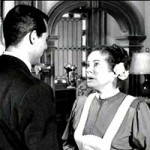 Elsa Lanchester is best remembered as Mary Shelley and the bride in The Bride of Frankenstein, and ten years after The Bishop’s Wife she would become Charles Laughton’s niggling nurse in Witness for the Prosecution. Now she is in a minor role as Matilda, the maid smitten by Dudley. Matilda swoons and scurries about to wait on him, even giving him a neck scarf the bishop has never worn. All the women, young and old, who come near Dudley are accordingly smitten. After all, Cary Grant is, once again, playing Cary Grant!
Elsa Lanchester is best remembered as Mary Shelley and the bride in The Bride of Frankenstein, and ten years after The Bishop’s Wife she would become Charles Laughton’s niggling nurse in Witness for the Prosecution. Now she is in a minor role as Matilda, the maid smitten by Dudley. Matilda swoons and scurries about to wait on him, even giving him a neck scarf the bishop has never worn. All the women, young and old, who come near Dudley are accordingly smitten. After all, Cary Grant is, once again, playing Cary Grant!
Starting in 1932, James Gleason had played Police Inspector Oscar Piper in the RKO Hildegarde Withers mystery series, most notably with original sleuthing schoolteacher, Edna May Oliver, although later, less effectively, with ZaSu Pitts and Helen Broderick. In The Bishop’s Wife, as Sylvester the cabbie, he accepts comfortably his typecasting as the familiar wise-cracker, looking astonished, bewildered or chagrined, as the script requires.
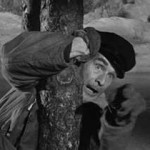 He participates in the winter skating scene—the pièce de résistance set of the movie. Hollywood during the ’40s did winter scenes, whether parks, frozen lakes or city streets, with great flair. Remember The Magnificent Ambersons, The Man Who Came to Dinner, Christmas in Connecticut, Portrait of Jennie, It’s a Wonderful Life? Dudley teaches Sylvester to skate and, along with Julia, they glide over the ice, Olympic style. Obvious doubles and, somehow, an unsettling disruption in the tone of the film, as is, later, Henry sticking to one of Agnes’ recently varnished chairs.
He participates in the winter skating scene—the pièce de résistance set of the movie. Hollywood during the ’40s did winter scenes, whether parks, frozen lakes or city streets, with great flair. Remember The Magnificent Ambersons, The Man Who Came to Dinner, Christmas in Connecticut, Portrait of Jennie, It’s a Wonderful Life? Dudley teaches Sylvester to skate and, along with Julia, they glide over the ice, Olympic style. Obvious doubles and, somehow, an unsettling disruption in the tone of the film, as is, later, Henry sticking to one of Agnes’ recently varnished chairs.
Two of the child stars in It’s a Wonderful Life, from the year before, make an appearance. Bobby Anderson (the pharmacist’s assistant), who died in 2008, plays a football captain, and Karolyn Grimes (his girl friend), is Debby, Julia and Henry’s daughter. She is welcomed into the football game when Dudley miraculously guides one of her snowballs, impressing the boys who had first rejected her.
A careful look among the other cast reveals all kinds of delights, like unexpected ingredients in an already unusual fruitcake. Sara Haden, as Henry’s secretary, was the spinster aunt in the Andy Hardy family series. Isabel Jewell has a one-time, maybe three-line part as a distressed mother whose baby has rolled away in its carriage, saved, of course, by Dudley. Her best role, of course, was Emmy Slattery in Gone with the Wind. Among the familiar but usually nameless actors who appear in the movies of the ’30s and ’40s, Regis Toomey is Mr. Miller, the choir director, Edgar Dearing, the proverbial cop, and Tito Vuolo, the owner of Michel’s restaurant.
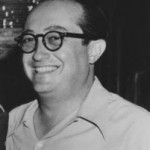 Many films in the 1930s and ’40s, even in the waning years of Hollywood’s Golden Age in 1947, possess outstanding craftsmen, a byproduct of the studio system. The director, Henry Koster, was a German of considerable diversity—My Cousin Rachel, The Robe, No Highway in the Sky, The Inspector General, Flower Drum Song. He was most at home in sentimental comedy—Good Morning, Miss Dove, It Started with Eve, The Luck of the Irish, Harvey, Mr. Belvedere Rings the Bell.
Many films in the 1930s and ’40s, even in the waning years of Hollywood’s Golden Age in 1947, possess outstanding craftsmen, a byproduct of the studio system. The director, Henry Koster, was a German of considerable diversity—My Cousin Rachel, The Robe, No Highway in the Sky, The Inspector General, Flower Drum Song. He was most at home in sentimental comedy—Good Morning, Miss Dove, It Started with Eve, The Luck of the Irish, Harvey, Mr. Belvedere Rings the Bell.
The cinematographer is one of the greats, Gregg Toland. To recall that The Bishop’s Wife was once colorized—does it still exist, somewhere, on some dark shelf, in this violated state?—is tantamount to computerizing Renoir’s On the Terrace to black and white! The sacrilege of colorization destroys the rich black and white shadings, the wonderful depth perspective, particularly of the bishop’s study, where many scenes take place and where Henry meets that angel.
 Composer Hugo Friedhofer began his Hollywood career as an orchestrator, most impressively for Erich Wolfgang Korngold, writing his first score, The Adventures of Marco Polo, in 1938. His crowning achievement, The Best Years of Our Lives (1946), won a deserved Oscar. Some of the harmonies and orchestral nuances of that music can be heard in The Bishop’s Wife—very subtly, of course, for the sense of the music here is quite different. There is an appropriate Christmas sparkle, with vague suggestions of carols and a main theme that hints at “Our God, Our Help in Ages Past.”
Composer Hugo Friedhofer began his Hollywood career as an orchestrator, most impressively for Erich Wolfgang Korngold, writing his first score, The Adventures of Marco Polo, in 1938. His crowning achievement, The Best Years of Our Lives (1946), won a deserved Oscar. Some of the harmonies and orchestral nuances of that music can be heard in The Bishop’s Wife—very subtly, of course, for the sense of the music here is quite different. There is an appropriate Christmas sparkle, with vague suggestions of carols and a main theme that hints at “Our God, Our Help in Ages Past.”
Leonardo Bercovici and Robert E. Sherwood wrote the script from Robert Nathan’s 1928 novel, although the famous writing team of Billy Wilder and Charles Brackett was not credited for its work.
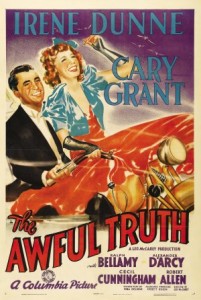 Besides Best Picture, The Bishop’s Wife was nominated for Koster’s direction, Friedhofer’s score and Monica Collingwood’s editing. Although surprisingly not nominated for Special Effects—Green Dolphin Street won for its earthquake and tidal wave—it did win an Oscar for Sound Recording.
Besides Best Picture, The Bishop’s Wife was nominated for Koster’s direction, Friedhofer’s score and Monica Collingwood’s editing. Although surprisingly not nominated for Special Effects—Green Dolphin Street won for its earthquake and tidal wave—it did win an Oscar for Sound Recording.
After five years in Hollywood and more than 25 films, Cary Grant’s career received a big boost in 1937 with The Awful Truth. In the ’40s, which must be regarded as his peak, came My Favorite Wife, His Girl Friday, The Philadelphia Story, Penny Serenade, Suspicion, None But the Lonely Heart, Arsenic and Old Lace, Notorious and Mr. Blandings Builds His Dream House. His two Oscar nominations were for Penny Serenade and None But the Lonely Heart, ultra-serious films outside the Grant persona. Thereafter, he remained generally in demand, to his last impressive film, Charade in 1963, though he would make two more before his retirement in 1967.
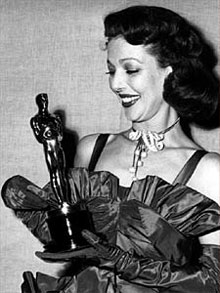 Loretta Young, who had a shorter and less distinguished Hollywood career than Grant, had more success with the Oscars, winning the year of The Bishop’s Wife for The Farmer’s Daughter. She was nominated, without winning, two years later for Come to the Stable, directed, once again, by Henry Koster, though she was clearly out-acted that year by Olivia de Havilland in The Heiress. In 1953 she had a big success in TV with The Loretta Young Show, returning after its end and its unsuccessful revival in 1963 for several TV dramas. In one, Christmas Eve, in 1986, Young played a terminally ill grandmother who seeks to reunite her estranged family.
Loretta Young, who had a shorter and less distinguished Hollywood career than Grant, had more success with the Oscars, winning the year of The Bishop’s Wife for The Farmer’s Daughter. She was nominated, without winning, two years later for Come to the Stable, directed, once again, by Henry Koster, though she was clearly out-acted that year by Olivia de Havilland in The Heiress. In 1953 she had a big success in TV with The Loretta Young Show, returning after its end and its unsuccessful revival in 1963 for several TV dramas. In one, Christmas Eve, in 1986, Young played a terminally ill grandmother who seeks to reunite her estranged family.
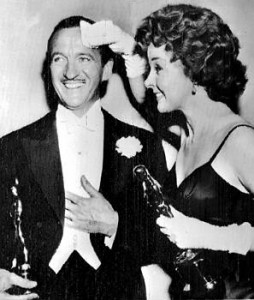 Despite a longer career than either Grant’s or Young’s, David Niven made fewer outstanding films, though gaining attention with Dodsworth in 1936 and The Prisoner of Zenda the following year. Something of a ten-year fallow period was broken in 1956 with Around the World in 80 Days. In 1958 he did his best work—and an Oscar—in Separate Tables, with, coincidentally, Gladys Cooper and a largely British cast. The last twenty-five years of his career, when he penned two autobiographies, produced generally mundane films. Sadly, his last was The Curse of the Pink Panther (1983), made not only with outtakes from previous films of its deceased star, Peter Sellers, but without Niven’s voice, which was dubbed by Rich Little. That year Niven would die of Lou Gehrig’s disease.
Despite a longer career than either Grant’s or Young’s, David Niven made fewer outstanding films, though gaining attention with Dodsworth in 1936 and The Prisoner of Zenda the following year. Something of a ten-year fallow period was broken in 1956 with Around the World in 80 Days. In 1958 he did his best work—and an Oscar—in Separate Tables, with, coincidentally, Gladys Cooper and a largely British cast. The last twenty-five years of his career, when he penned two autobiographies, produced generally mundane films. Sadly, his last was The Curse of the Pink Panther (1983), made not only with outtakes from previous films of its deceased star, Peter Sellers, but without Niven’s voice, which was dubbed by Rich Little. That year Niven would die of Lou Gehrig’s disease.
Today, when fewer and fewer people believe in God, the more sophisticated among us would suggest that The Bishop’s Wife administers too generous a dose of religious hokum, without anesthesia or health warning labels. But what heart-warming sentiments after all, and what wonderful ensemble acting, brilliant photography and intelligent dialogue. It was a more innocent time then, in 1947, although World War II had replaced much of the innocence of life with its harsher realities. There had been, earlier, WWI and the Great Depression, and in 1948 would come the Berlin Airlift, the first marker in the Cold War and, later still, deadly “police actions” and unending “containments.”
